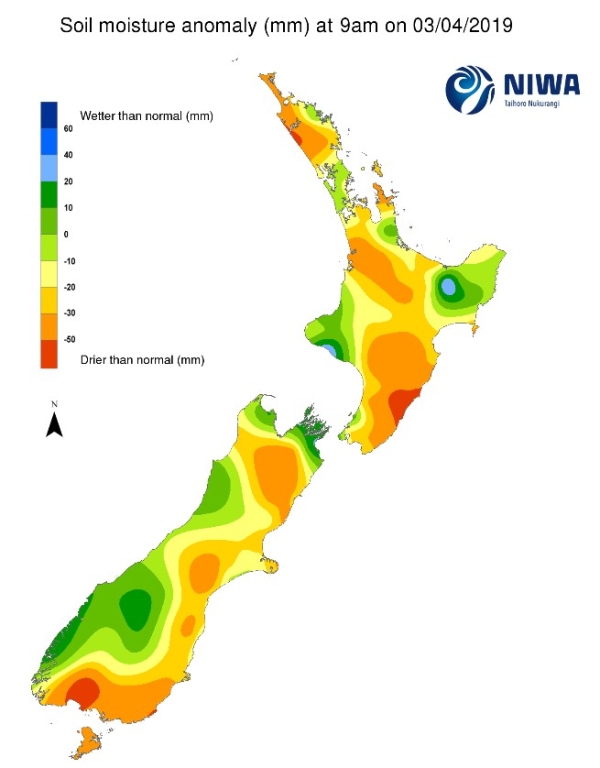A weekly update describing soil moisture across the country to help assess whether severely to extremely dry conditions are occurring or imminent. Regions experiencing these soil moisture deficits are deemed “hotspots”. Persistent hotspot regions have the potential to develop into drought.
Facts: Soil Moisture
Across the North Island, soil moisture levels increased substantially in many areas during the past week, while only a couple of localised areas experienced small soil moisture decreases. The most significant increases were observed in parts of Northland, Auckland, Waikato, eastern Bay of Plenty, Gisborne, and Taranaki. Meanwhile, small soil moisture decreases occurred in western Northland and coastal Wairarapa. The driest soils across the North Island compared to normal for this time of the year are found in western Northland and coastal Wairarapa, while the wettest soils for this time of the year are located in eastern Bay of Plenty and southern Taranaki.
Hotspot coverage in the North Island decreased substantially in the past week due to many areas receiving moderate to heavy rainfall. However, hotspots remain in place across western Northland and Aupouri Peninsula, a small portion of central Waikato, southern Manawatu-Whanganui, and much of Wairarapa and southern Hawke’s Bay.
In the South Island, soil moisture levels generally did not change significantly in the past week. Far northern areas saw some additional soil moisture increases, while the rest of the South Island generally observed minor soil moisture decreases. This decrease was most notable in eastern areas from northern Canterbury to Otago. The driest soils across the South Island compared to normal for this time of the year are found in lower Southland, while the wettest soils for this time of the year are found in the Marlborough Sounds area.
South Island hotspots are currently found in a disjointed line down the eastern coast from northern Canterbury to the Clutha District, including much of Banks Peninsula.
Outlook and Soil Moisture
In the North Island, rainfall amounts through Friday (5 April) will generally be light, although isolated moderate amounts will be possible in Northland due to shower activity. During the upcoming weekend, weak low pressure forming near or just east of the North Island will bring moderate rainfall to eastern areas that may last into early next week. Depending on the location of this low pressure, moderate rainfall could also affect the upper North Island this weekend. Drier weather will likely return to the North Island by Tuesday and Wednesday (9-10 April). Total rainfall amounts in the next week could reach 30-50 mm from Gisborne to Wellington-Wairarapa, with localised amounts up to 30 mm in the upper North Island. Elsewhere, amounts of 20 mm or less are expected.
Due to the anticipated rainfall in the next week, soil moisture improvements would be expected along the east coast, likely weakening the hotspots present there. Should moderate rainfall also occur in the upper North Island, some improvements may also be found there. Meanwhile, western areas may see slight soil moisture decreases in the next week.
In the South Island, a front moving north today and on Friday (5 April) will produce generally 5-15 mm for many areas, and perhaps a bit more in central and northern Canterbury. During the upcoming weekend, low pressure near the North Island could bring more moderate rain to northern Canterbury and Marlborough, while other areas remain mostly dry. By Wednesday (10 April), another front could bring moderate rain to the West Coast and another 5-15 mm to Southland and Otago.
Potential moderate rainfall amounts across Marlborough and northern Canterbury could help weaken or eliminate hotspots in those areas, although not much change in the soil moisture situation is expected in southern Canterbury in the next week. Some improvements could also be found across Southland, while soils may begin to dry in Nelson and nearby parts of Tasman.
Background:
Hotspot Watch: a weekly advisory service for New Zealand media. It provides soil moisture and precipitation measurements around the country to help assess whether extremely dry conditions are imminent.
Soil moisture deficit: the amount of water needed to bring the soil moisture content back to field capacity, which is the maximum amount of water the soil can hold.
Soil moisture anomaly: the difference between the historical normal soil moisture deficit (or surplus) for a given time of year and actual soil moisture deficits.
Definitions: “Extremely” and “severely” dry soils are based on a combination of the current soil moisture status and the difference from normal soil moisture (see soil moisture maps at https://www.niwa.co.nz/climate/nz-drought-monitor/droughtindicatormaps)
Hotspot: A hotspot is declared if soils are "severely drier than normal" which occurs when Soil Moisture Deficit (SMD) is less than -110 mm AND the Soil Moisture Anomaly is less than -20 mm.



